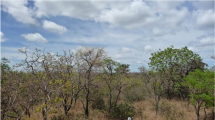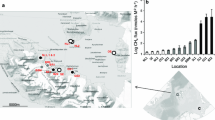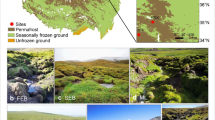Abstract
Climate change is warming tundra ecosystems in the Arctic, resulting in the decomposition of previously-frozen soil organic matter (SOM) and release of carbon (C) to the atmosphere; however, the processes that control SOM decomposition and C emissions remain highly uncertain. In this study, we evaluate geochemical factors that influence microbial production of carbon dioxide (CO2) and methane (CH4) in the seasonally-thawed active layer of interstitial polygonal tundra near Barrow, Alaska. We report spatial and seasonal patterns of dissolved gases in relation to the geochemical properties of Fe and organic C in soil and soil solution, as determined using spectroscopic and chromatographic techniques. The chemical composition of soil water collected during the annual thaw season varied significantly with depth. Soil water in the middle of the active layer contained abundant Fe(III), and aromatic-C and low-molecular-weight organic acids derived from SOM decomposition. At these depths, CH4 was positively correlated with the ratio of Fe(III) to total Fe in waterlogged transitional and low-centered polygons but negatively correlated in the drier flat- and high-centered polygons. These observations contradict the expectation that CH4 would be uniformly low where Fe(III) was high due to inhibition of methanogenesis by Fe(III)-reduction reactions. Our results suggest that vertically-stratified Fe redox reactions influence respiration/fermentation of SOM and production of substrates (e.g., low-molecular-weight organic acids) for methanogenesis, but that these effects vary with soil moisture. We infer that geochemical differences induced by water saturation dictate microbial products of SOM decomposition, and Fe geochemistry is an important factor regulating methanogenesis in anoxic tundra soils.







Similar content being viewed by others
References
Baldock JA, Skjemstad JO (2000) Role of the soil matrix and minerals in protecting natural organic materials against biological attack. Org Geochem 31(7):697–710
Bethke CM, Sanford RA, Kirk MF, Jin Q, Flynn TM (2011) The thermodynamic ladder in geomicrobiology. Am J Sci 311(3):183–210
Bockheim JG, Everett LR, Hinkel KM, Nelson FE, Brown J (1999) Soil organic carbon storage and distribution in arctic tundra, Barrow, Alaska. Soil Sci Soc Am J 63(4):934–940
Bockheim JG, Hinkel KM, Nelson FE (2003) Predicting carbon storage in tundra soils of arctic Alaska. Soil Sci Soc Am J 67(3): 948–950
Bond DR, Lovley DR (2002) Reduction of Fe(III) oxide by methanogens in the presence and absence of extracellular quinones. Environ Microbiol 4(2):115–124
Brown J (1969) Ionic concentration gradients in permafrost, Barrow, Alaska. Cold Regions Research and Engineering Lab, Hanover NH. No. CRREL-RR-272
Byrne JM, Klueglein N, Pearce C, Rosso KM, Appel E, Kappler A (2015) Redox cycling of Fe(II) and Fe(III) in magnetite by Fe-metabolizing bacteria. Science 347(6229):1473–1476
Chen J, Gu B, LeBoeuf EJ, Pan H, Dai S (2002) Spectroscopic characterization of the structural and functional properties of natural organic matter fractions. Chemosphere 48(1):59–68
Gu B, Schmitt J, Chen Z, Liang L, McCarthy JF (1994) Adsorption and desorption of natural organic matter on iron oxide: mechanisms and models. Environ Sci Technol 28(1):38–46
Gu B, Schmitt J, Chen Z, Liang L, McCarthy JF (1995) Adsorption and desorption of different organic matter fractions on iron oxide. Geochim Cosmochim Acta 59(2):219–229
Gu B, Mehlhorn TL, Liang L, McCarthy JF (1996) Competitive adsorption, displacement, and transport of organic matter on iron oxide: I. Competitive adsorption. Geochim Cosmochim Acta 60(11):1943–1950
Hansel CM, Benner SG, Neiss J, Dohnalkova A, Kukkadapu RK, Fendorf S (2003) Secondary mineralization pathways induced by dissimilatory iron reduction of ferrihydrite under advective flow. Geochim Cosmochim Acta 67(16):2977–2992
Heimann M, Reichstein M (2008) Terrestrial ecosystem carbon dynamics and climate feedbacks. Nature 451(7176):289–292
Herndon EM, Mann BF, Roy Chowdhury T, Yang Z, Wullschleger SD, Graham D, Liang L, Gu B (2015a) Pathways of anaerobic organic matter decomposition in tundra soils from Barrow, Alaska. J Geophys Res Biogeosci. doi:10.1002/2015JG003147
Herndon EM, Yang Z, Graham DE, Wullschleger SD, Gu B, Liang L (2015b) Surface and active layer pore water chemistry from ice wedge polygons, Barrow, Alaska, 2013–2014. In: Next generation ecosystem experiments arctic data collection, Carbon Dioxide Information Analysis Center, Oak Ridge National Laboratory, Oak Ridge. http://dx.doi.org/10.5440/1226245
Hinkel KM, Paetzold F, Nelson FE, Bockheim JG (2001) Patterns of soil temperature and moisture in the active layer and upper permafrost at Barrow, Alaska: 1993–1999. Global Planet Change 29(3):293–309
Hinkel KM, Frohn RC, Nelson FE, Eisner WR, Beck RA (2005) Morphometric and spatial analysis of thaw lakes and drained thaw lake basins in the western Arctic Coastal Plain, Alaska. Permafr Periglac Process 16(4):327–341
Hubbard SS, Gangodagamage C, Dafflon B, Wainwright H, Peterson J, Gusmeroli A, Wullschleger SD (2013) Quantifying and relating land-surface and subsurface variability in permafrost environments using LiDAR and surface geophysical datasets. Hydrogeol J 21(1):149–169
Jensen HS, Kristensen P, Jeppesen E, Skytthe A (1992) Iron: phosphorus ratio in surface sediment as an indicator of phosphate release from aerobic sediments in shallow lakes. In: Sediment/water interactions. Springer, Netherlands, pp 731–743
Karlsson T, Persson P (2010) Coordination chemistry and hydrolysis of Fe(III) in a peat humic acid studied by X-ray absorption spectroscopy. Geochim Cosmochim Acta 74:30–40
Karlsson T, Persson P (2012) Complexes with aquatic organic matter suppress hydrolysis and precipitation of Fe(III). Chem Geol 322:19–27
Karlsson T, Persson P, Skyllberg U, Mörth CM, Giesler R (2008) Characterization of iron(III) in organic soils using extended X-ray absorption fine structure spectroscopy. Environ Sci Technol 42(15):5449–5454
Kato S, Hashimoto K, Watanabe K (2012) Methanogenesis facilitated by electric syntrophy via (semi) conductive iron-oxide minerals. Environ Microbiol 14(7):1646–1654
Kim Y (2015) Effect of thaw depth on fluxes of CO2 and CH4 in manipulated Arctic coastal tundra of Barrow, Alaska. Sci Total Environ 505:385–389
Kokelj SV, Burn CR (2003) Ground ice and soluble cations in near-surface permafrost, Inuvik, Northwest Territories, Canada. Permafr Periglac Process 14(3):275–289
Kokelj SV, Burn CR (2005) Geochemistry of the active layer and near-surface permafrost, Mackenzie delta region, Northwest Territories, Canada. Can J Earth Sci 42(1):37–48
Koven CD, Lawrence DM, Riley WJ (2015) Permafrost carbon—climate feedback is sensitive to deep soil carbon decomposability but not deep soil nitrogen dynamics. Proc Natl Acad Sci 112(12):3752–3757
Lacelle D, Juneau V, Pellerin A, Lauriol B, Clark ID (2008) Weathering regime and geochemical conditions in a polar desert environment, Haughton impact structure region, Devon Island, Canada. Can J Earth Sci 45(10):1139–1157
Lara MJ, McGuire AD, Euskirchen ES, Tweedie CE, Hinkel KM, Skurikhin AN, Genet H (2014) Polygonal tundra geomorphological change in response to warming alters future CO2 and CH4 flux on the Barrow Peninsula. Glob Change Biol. doi:10.1111/gcb.12757
Liang L, Morgan JJ (1990) Chemical aspects of iron oxide coagulation in water: laboratory studies and implication for natural systems. Aquat Sci 52:32–55
Liang L, McCarthy JF, Jolley LW, McNabb JA, Mehlhorn TL (1993) Iron dynamics-observations of transformation during injection of natural organic matter in a sandy aquifer. Geochim Cosmochim Acta 57:1987–1999
Liang L, Hofmann A, Gu B (2000) Ligand-induced dissolution and release of ferrihydrite colloids. Geochim Cosmochim Acta 64(12):2027–2037
Liljedahl AK, Hinzman LD, Schulla J (2012) Ice-wedge polygon type controls low-gradient watershed-scale hydrology. In: Tenth International Conference on Permafrost, Salekhard
Lipson DA, Jha M, Raab TK, Oechel WC (2010) Reduction of iron (III) and humic substances plays a major role in anaerobic respiration in an Arctic peat soil. J Geophys Res. doi:10.1029/2009JG001147
Lipson DA, Zona D, Raab TK, Bozzolo F, Mauritz M, Oechel WC (2012) Water table height and microtopography control Biogeochemical cycling in an Arctic coastal tundra Ecosystem. Biogeosciences 9:577–591
Lipson DA, Raab TK, Goria D, Zlamal J (2013) The contribution of Fe(III) and humic acid reduction to ecosystem respiration in drained thaw lake basins of the Arctic Coastal Plain. Glob Biogeochem Cycles 27(2):399–409
Lovley DR, Phillips EJ (1988) Novel mode of microbial energy metabolism: organic carbon oxidation coupled to dissimilatory reduction of iron or manganese. Appl Environ Microbiol 54(6):1472–1480
Lovley DR, Stolz JF, Nord GL, Phillips EJ (1987) Anaerobic production of magnetite by a dissimilatory iron-reducing microorganism. Nature 330(6145):252–254
Brown J, Everett KR, Webber PJ, MacLean Jr, SF, Murray DF (1980) The coastal tundra at Barrow. An arctic ecosystem: the coastal tundra at Barrow, Alaska. pp 1–29
Metje M, Frenzel P (2007) Methanogenesis and methanogenic pathways in a peat from subarctic permafrost. Environ Microbiol 9(4):954–964
Miller KE, Lai CT, Friedman ES, Angenent LT, Lipson DA (2015) Methane suppression by iron and humic acids in soils of the Arctic Coastal Plain. Soil Biol Biochem 83:176–183
Moosavi SC, Crill PM (1998) CH4 oxidation by tundra wetlands as measured by a selective inhibitor technique. J Geophys Res 103(D22):29093–29106
Newman BD, Throckmorton HM, Graham DE, Gu B, Hubbard SS, Liang L, Wullschleger SD (2015) Microtopographic and depth controls on active layer chemistry in arctic polygonal ground. Geophys Res Lett 42(6):1808–1817
Paytan A, Lecher AL, Dimova N, Sparrow KJ, Kodovska FGT, Murray J, Kessler JD (2015) Methane transport from the active layer to lakes in the Arctic using Toolik Lake, Alaska, as a case study. Proc Natl Acad Sci 112(12):3636–3640
Pearce DME, Clymo RS (2001) Methane oxidation in a peatland core. Glob Biogeochem Cycles 15(3):709–720
Regier T, Krochak J, Sanders DA, Hu Y-F, Thompson J, Blyth RIR (2007) Performance and capabilities of the Canadian dragon: the SGM beamline at the Canadian light source, nuclear instruments and methods. Phys Res A 582: 93–95. Beamlines: SGM (11ID-1)
Regier T, Paulsen J, Wright G, Coulthard I, Tan K, Sanders DA, Blyth RIR (2007) Commissioning of the spherical grating monochromator (SGM) soft x-ray spectroscopy Beamline at the Canadian light source, Synchrotron Radiation Instrumentation: Ninth International Conference CP879, pp 473–476. Beamlines: SGM (11ID-1)
Rentz JA, Turner IP, Ullman JL (2009) Removal of phosphorus from solution using biogenic iron oxides. Water Res 43(7):2029–2035
Riley WJ, Subin ZM, Lawrence DM, Swenson SC, Torn MS, Meng L, Hess P (2011) Barriers to predicting changes in global terrestrial methane fluxes: analyses using CLM4Me, a methane biogeochemistry model integrated in CESM. Biogeosciences 8(7):1925–1953
Roden EE, Wetzel RG (1996) Organic carbon oxidation and suppression of methane production by microbial Fe(III) oxide reduction in vegetated and unvegetated freshwater wetland sediments. Limnol Oceanogr 41(8):1733–1748
Roy Chowdhury T, Herndon EM, Phelps TJ, Elias DA, Gu B, Liang L, Wullschleger SD, Graham DE (2015) Stoichiometry and temperature sensitivity of methanogenesis and CO2 production from saturated polygonal tundra in Barrow, Alaska. Glob Change Biol 21(2):722–737
Schuur EA, Bockheim J, Canadell JG, Euskirchen E, Field CB, Goryachkin SV, Zimov SA (2008) Vulnerability of permafrost carbon to climate change: implications for the global carbon cycle. Bioscience 58(8):701–714
Schuur EA, Vogel JG, Crummer KG, Lee H, Sickman JO, Osterkamp TE (2009) The effect of permafrost thaw on old carbon release and net carbon exchange from tundra. Nature 459(7246):556–559
Shannon RD, White JR (1994) A three-year study of controls on methane emissions from two Michigan peatlands. Biogeochemistry 27(1):35–60
Shiklomanov NI, Streletskiy DA, Nelson FE, Hollister RD, Romanovsky VE, Tweedie CE, Bockheim JG, Brown J (2010) Decadal variations of active‐layer thickness in moisture‐controlled landscapes, Barrow, Alaska. J Geophys Res. doi:10.1029/2009JG001248
Smith LC, Sheng Y, MacDonald GM, Hinzman LD (2005) Disappearing arctic lakes. Science 308(5727):1429
Solomon D, Lehmann J, Kinyangi J, Liang B, Schäfer T (2005) Carbon K-edge NEXAFS and FTIR-ATR spectroscopic investigation of organic carbon speciation in soils. Soil Sci Soc Am J 69(1):107–119
Stocker TF, Qin D, Plattner GK, Tignor M, Allen SK, Boschung J, Midgley BM (2013) IPCC, 2013: climate change 2013: the physical science basis. Contribution of working group I to the fifth assessment report of the intergovernmental panel on climate change
Stolpe B, Guo L, Shiller AM, Aiken GR (2013) Abundance, size distributions and trace-element binding of organic and iron-rich nanocolloids in Alaskan rivers, as revealed by field-flow fractionation and ICP-MS. Geochim Cosmochim Acta 105:221–239
Sturtevant CS, Oechel WC (2013) Spatial variation in landscape-level CO2 and CH4 fluxes from arctic coastal tundra: influence from vegetation, wetness, and the thaw lake cycle. Glob Change Biol 19(9):2853–2866
Tarnocai C, Canadell JG, Schuur EAG, Kuhry P, Mazhitova G, Zimov S (2009) Soil organic carbon pools in the northern circumpolar permafrost region. Glob Biogeochem Cycles. doi:10.1029/2008GB003327
Throckmorton HM, Heikoop JM, Newman BD, Altmann GL, Conrad MS, Muss JD, Perkins GB, Smith LJ, Torn MS, Wullschleger SD, Wilson CJ (2015) Pathways and transformations of dissolved methane and dissolved inorganic carbon in Arctic tundra watersheds: evidence from analysis of stable isotopes. Global Biogeochem Cycles. doi:10.1002/2014GB005044
Turetsky MR, Treat CC, Waldrop MP, Waddington JM, Harden JW, McGuire AD (2008) Short-term response of methane fluxes and methanogen activity to water table and soil warming manipulations in an Alaskan peatland. J Geophys Res 113(G3):134
Ueyama M, Iwata H, Harazono Y, Euskirchen ES, Oechel WC, Zona D (2013) Growing season and spatial variations of carbon fluxes of Arctic and boreal ecosystems in Alaska (USA). Ecol Appl 23(8):1798–1816
von Fischer JC, Rhew RC, Ames GM, Fosdick BK, von Fischer PE (2010) Vegetation height and other controls of spatial variability in methane emissions from the Arctic coastal tundra at Barrow, Alaska. J Geophys Res 115(G4):33
Wainwright HM, Dafflon B, Smith LJ, Hahn MS, Curtis JB, Wu Y, Hubbard SS (2015) Identifying multiscale zonation and assessing the relative importance of polygon geomorphology on carbon fluxes in an Arctic Tundra Ecosystem. J Geophys Res. doi: 10.1002/2014JG002799
Webb SM (2005) SIXpack: a graphical user interface for XAS analysis using IFEFFIT. Phys Scr T115:1011–1014. doi:10.1238/Physica.Topical.115a01011
Weber KA, Achenbach LA, Coates JD (2006) Microorganisms pumping iron: anaerobic microbial iron oxidation and reduction. Nat Rev Microbiol 4(10):752–764
Weishaar JL, Aiken GR, Bergamaschi BA, Fram MS, Fujii R, Mopper K (2003) Evaluation of specific ultraviolet absorbance as an indicator of the chemical composition and reactivity of dissolved organic carbon. Environ Sci Technol 37(20):4702–4708
Wieder WR, Cleveland CC, Smith WK, Todd-Brown K (2015) Future productivity and carbon storage limited by terrestrial nutrient availability. Nat Geosci 8(6):441–444
Zhuang Q, Melillo JM, McGuire AD, Kicklighter DW, Prinn RG, Steudler PA, Hu S (2007) Net emissions of CH4 and CO2 in Alaska: implications for the region’s greenhouse gas budget. Ecol Appl 17(1):203–212
Zona D, Lipson DA, Zulueta RC, Oberbauer SF, Oechel WC (2011) Microtopographic controls on ecosystem functioning in the Arctic Coastal Plain. J Geophys Res. doi:10.1029/2009JG001241
Zona D, Lipson DA, Paw U, Kyaw T, Oberbauer SF, Olivas P, Gioli B, Oechel WC (2012) Increased CO2 loss from vegetated drained lake tundra ecosystems due to flooding. Glob Biogeochem Cycles. doi:10.1029/2011GB004037
Acknowledgments
The authors would like to thank Kenneth Lowe for core sample collection, and Taniya Roy Chowdhury, Xiangping Yin, Benjamin Mann, Tonia Mehlhorn, Sharon Bone, Jay Dynes, Margaret Murphy, and Henry Gong for technical assistance and chemical analyses. All data are available in the supporting information for this manuscript and in an online data repository (NGEE-Arctic Data Portal). The Next Generation Ecosystem Experiments (NGEE-Arctic) project and the SLAC Science Focus Area (SFA) program are supported by the US Department of Energy (DOE) Office of Biological and Environmental Research. Oak Ridge National Laboratory is managed by UT-Battelle LLC for DOE under contract DE-AC05-00OR22725. Portions of this work were performed at the Stanford Synchrotron Radiation Lightsource (SSRL) and the Canadian Light Source (CLS). SSRL (a directorate of SLAC) is supported by the U.S. DOE, Office of Science, Office of Basic Energy Sciences under Contract No. DE-AC02-76SF00515. The CLS is supported by the Canadian Foundation for Innovation, Natural Sciences and Engineering Research Council of Canada, the University of Saskatchewan, the Government of Saskatchewan, Western Economic Diversification Canada, the National Research Council Canada, and the Canadian Institutes of Health Research. Logistical support while working on the Barrow Environmental Observatory (BEO) was provided by Umiaq, LLC.
Author information
Authors and Affiliations
Corresponding authors
Additional information
Responsible Editor: Stephen Porder.
Electronic supplementary material
Below is the link to the electronic supplementary material.
Rights and permissions
About this article
Cite this article
Herndon, E.M., Yang, Z., Bargar, J. et al. Geochemical drivers of organic matter decomposition in arctic tundra soils. Biogeochemistry 126, 397–414 (2015). https://doi.org/10.1007/s10533-015-0165-5
Received:
Accepted:
Published:
Issue Date:
DOI: https://doi.org/10.1007/s10533-015-0165-5




